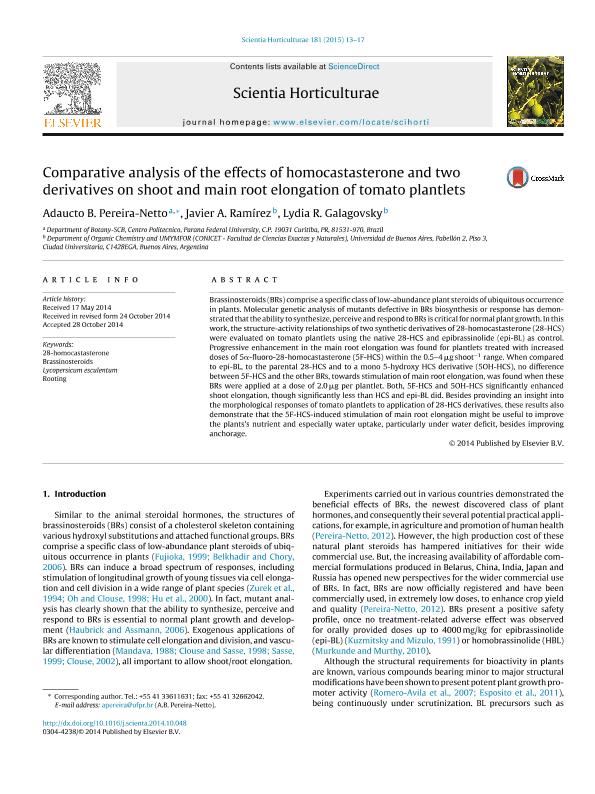Mostrar el registro sencillo del ítem
dc.contributor.author
Pereira Netto, Adaucto B.

dc.contributor.author
Ramirez, Javier Alberto

dc.contributor.author
Galagovsky, Lydia Raquel

dc.date.available
2017-06-22T18:10:11Z
dc.date.issued
2015-01
dc.identifier.citation
Pereira Netto, Adaucto B.; Ramirez, Javier Alberto; Galagovsky, Lydia Raquel; Comparative analysis of the effects of homocastasterone and two derivatives on shoot and main root elongation of tomato plantlets; Elsevier Science; Scientia Horticulturae; 181; 1-2015; 13-17
dc.identifier.issn
0304-4238
dc.identifier.uri
http://hdl.handle.net/11336/18663
dc.description.abstract
Brassinosteroids (BRs) comprise a specific class of low-abundance plant steroids of ubiquitous occurrence in plants. Molecular genetic analysis of mutants defective in BRs biosynthesis or response has demonstrated that the ability to synthesize, perceive and respond to BRs is critical for normal plant growth. In this work, the structure-activity relationships of two synthetic derivatives of 28-homocastasterone (28-HCS) were evaluated on tomato plantlets using the native 28-HCS and epibrassinolide (epi-BL) as control. Progressive enhancement in the main root elongation was found for plantlets treated with increased doses of 5α-fluoro-28-homocastasterone (5F-HCS) within the 0.5–4 μg shoot−1 range. When compared to epi-BL, to the parental 28-HCS and to a mono 5-hydroxy HCS derivative (5OH-HCS), no difference between 5F-HCS and the other BRs, towards stimulation of main root elongation, was found when these BRs were applied at a dose of 2.0 μg per plantlet. Both, 5F-HCS and 5OH-HCS significantly enhanced shoot elongation, though significantly less than HCS and epi-BL did. Besides provinding an insight into the morphological responses of tomato plantlets to application of 28-HCS derivatives, these results also demonstrate that the 5F-HCS-induced stimulation of main root elongation might be useful to improve the plants's nutrient and especially water uptake, particularly under water deficit, besides improving anchorage.
dc.format
application/pdf
dc.language.iso
eng
dc.publisher
Elsevier Science

dc.rights
info:eu-repo/semantics/openAccess
dc.rights.uri
https://creativecommons.org/licenses/by-nc-nd/2.5/ar/
dc.subject
28-Homocastasterone
dc.subject
Brassinosteroids
dc.subject
Lycopersicum Esculentum
dc.subject
Rooting
dc.subject.classification
Ciencias de las Plantas, Botánica

dc.subject.classification
Ciencias Biológicas

dc.subject.classification
CIENCIAS NATURALES Y EXACTAS

dc.title
Comparative analysis of the effects of homocastasterone and two derivatives on shoot and main root elongation of tomato plantlets
dc.type
info:eu-repo/semantics/article
dc.type
info:ar-repo/semantics/artículo
dc.type
info:eu-repo/semantics/publishedVersion
dc.date.updated
2017-06-22T17:38:03Z
dc.journal.volume
181
dc.journal.pagination
13-17
dc.journal.pais
Países Bajos

dc.journal.ciudad
Amsterdam
dc.description.fil
Fil: Pereira Netto, Adaucto B.. Universidade Federal Do Parana; Brasil
dc.description.fil
Fil: Ramirez, Javier Alberto. Consejo Nacional de Investigaciones Científicas y Técnicas. Oficina de Coordinación Administrativa Ciudad Universitaria. Unidad de Microanálisis y Métodos Físicos en Química Orgánica. Universidad de Buenos Aires. Facultad de Ciencias Exactas y Naturales. Unidad de Microanálisis y Métodos Físicos en Química Orgánica; Argentina
dc.description.fil
Fil: Galagovsky, Lydia Raquel. Consejo Nacional de Investigaciones Científicas y Técnicas. Oficina de Coordinación Administrativa Ciudad Universitaria. Unidad de Microanálisis y Métodos Físicos en Química Orgánica. Universidad de Buenos Aires. Facultad de Ciencias Exactas y Naturales. Unidad de Microanálisis y Métodos Físicos en Química Orgánica; Argentina
dc.journal.title
Scientia Horticulturae

dc.relation.alternativeid
info:eu-repo/semantics/altIdentifier/doi/https://doi.org/10.1016/j.scienta.2014.10.048
dc.relation.alternativeid
info:eu-repo/semantics/altIdentifier/url/http://www.sciencedirect.com/science/article/pii/S0304423814005974
Archivos asociados
